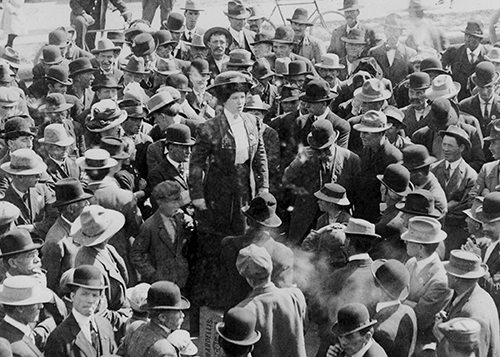
Anniversary exhibit draws comparison to current political climate

By Kendra Atleework | Downtown News
In honor of the 100th anniversary of the fight for free speech in America, Centro Cultural de la Raza, located at 2004 Park Blvd. in Balboa Park, will feature the San Diego Free Speech Fight 100-Year Anniversary exhibit. Running through Feb. 12, this exhibit includes photos, first-hand accounts and media reports surrounding the San Diego free speech fights in 1912.
Other highlights of the exhibit include an exploration of California’s labor history and work by local artists. Secretary, Treasurer and CEO of the San Diego and Imperial Counties Labor Council Lorena Gonzalez said the exhibit is “truly is a must see for all San Diegans.”
The 1912 movement began when city officials banned free speech and assembly for 49 square blocks in downtown San Diego. Jim Miller, author and professor of labor relations at San Diego City College, said that, at the time, the ordinance was one of the most severe free speech bans to have occurred in the United States.
Miller said the ordinance targeted the Gaslamp District, which was frequented by working class people from many ethnic backgrounds, and was ripe organizing territory for progressive activists. The activists most feared by San Diego’s government and ruling class, Miller explained, were union organizers promoting Industrial Workers of the World (IWW).
Miller called the IWW unique because it embraced workers of all ethnicities. IWW members, also called “wobblies,” organized workers by delivering public speeches that often pointed out the excess wealth of large San Diego corporations compared to the relative poverty of many workers.
Although there were only 50 IWW members in San Diego in 1912, Miller explained that this small group met with intense repression at the hands of the ruling class due to the changes the IWW members posed to the city’s economic and cultural future. “The free speech fight was a strong indicator that the city’s elite did not want an unruly, organized working class population,” Miller said.

Free speech and assembly rights were restored in San Diego within the year, however Miller pointed out the fight of 1912 is still underway by illuminating similarities in today’s political climate. “The local right [wing] wants to make San Diego the Wisconsin of the West by attacking unions and ensuring that folks in low paying, service sector jobs stay passive and unorganized while the elites run the show,” he said.
Miller said there is an “obvious and striking parallel” between the political climate, actions of dissent and methods of repression that occurred during the 1912 free speech fight and the current action surrounding the Occupy San Diego movement.
“We have moved back to a situation of massive economic inequality in this country, much like a century ago,” he said, “and people are beginning to fight back.”
Gonzalez agreed, saying, “The Occupy movement brings back vivid memories of civil disobedience with issues of free speech and freedom of assembly that took place in San Diego 100 years ago.”
Both Miller and Gonzalez stress the lessons they hope viewers take from the Balboa Park exhibit. “If something like banning free speech by an overzealous city council can happen once, then it can happen again if we aren’t careful,” Gonzalez said.
Miller added, “The lesson is those rights we think of as fixed and eternal can, and have been, taken away. We need to fight to preserve them.”
The exhibit will be at Centro Cultural de la Raza Tuesdays through Sundays through Feb. 12 from noon to 4 p.m. For more information call (619) 235-6135 or visit centroculturaldelaraza.org.












Discussion about this post